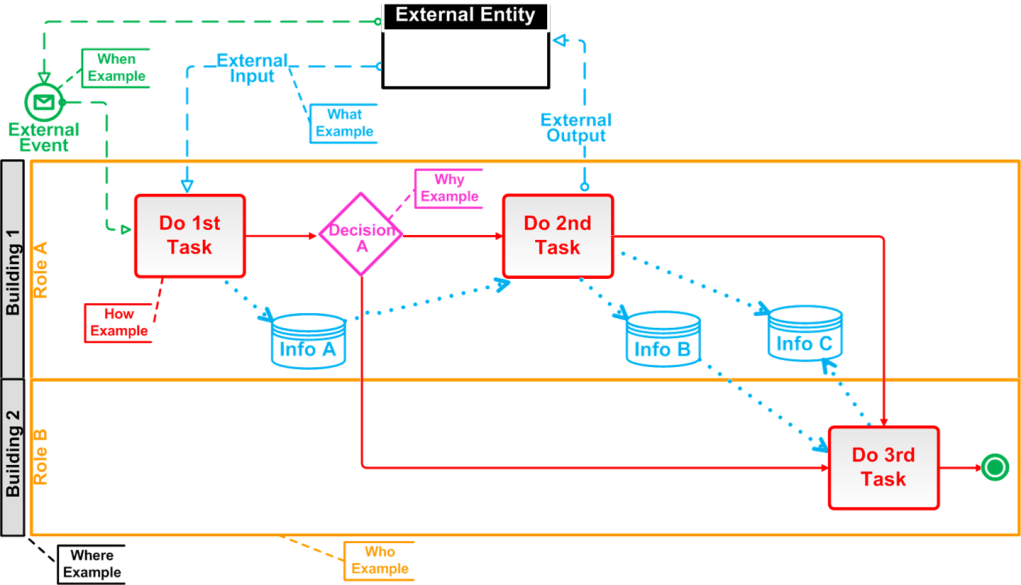This is the second article in a 4-part series of articles on architecture presented by the BAInstitiute. If the reader has not read the first article in this series, the reader is encouraged to click here to read part 1 the series in its proper sequence.
In the first article of this series, the reader was asked to visualize how to create a typical low-level workflow model from an enterprise template of architectural primitives or formally defined elements of the enterprise. In the Business Architecture (BA) tool referenced in the first article, all of these design elements were operationally current and available from the enterprise template to quickly build low-level workflows. The workflow creation was illustrated in a short youtube animation on how to use the enterprise template to assemble a generic workflow.
The first article in this series may lead the reader may to ask, “From where does the enterprise template come and how does one create the enterprise template of primitives or formally defined enterprise wide elements which are available for reuse across the enterprise?” This enterprise template is initially created from all of the available BPM workflows, preferably the lowest level workflows. IMAGINE it this way! Each element from Figure 1 below is DE-constructed from all of the lowest level composite workflow models, normalized (e.g. redundancies eliminated) and classified into one of six categories—WHAT, HOW, WHERE, WHO, WHEN and WHY. These categories are referred to as interrogatives.

Figure 1. Generic Composite Workflow Model with Formally Named Elements
As stated in the first article of this series, each primitive is unique in the enterprise and normalized, but not unique as to how it is implemented in the enterprise. To see a manifestation of the DE-construction visualization just described, the reader is asked to click on the following PowerPoint animation loaded out on youtube to see the DE-construction of a workflow model using the enterprise template of primitives or formally defined elements of the enterprise. The animation runs less than 45 seconds. This is an example of real Business Architecture in action!
Once the DE-construction of all of the available lowest-level BPM workflows is complete, normalized and classified according to the six interrogatives—WHAT, HOW, WHERE, WHO, WHEN and WHY—anyone may start to assemble new and/or enhanced low-level workflows using the enterprise template. And when necessary, one can add new primitives or formally named elements as desired.
Oh by the way, IMAGINE that the workflows are not simply displayed using the BA tool from a finished static composite model stored as depicted in Figure 1 of this article, but dynamically assembled by connecting one primitive element to another, and to another, and so on. This was illustrated by the animation in the first article of this series. If one could significantly slow down the speed of the display on a computer screen by the BA tool and repository (e.g. taking 45 seconds to build the display instead of less than a second), one would observe each primitive “fly in” from the row of interrogatives, get combined with other primitives and in some instances, get aggregated up to a higher level for presentation purposes. Only the model’s general appearance and positioning of primitives and aggregates are governed by the owner. Metaphorically speaking, this visualization is similar to some creative auto company TV advertisements where all of the integrated components/parts for a car (or truck) seem to “fly in” to the center of the TV screen and get assembled into an image of a car (or truck). Then the image somehow magically transforms into an operational car (or truck) all within a few seconds.[1] But that magical transformation can only instantly happen on TV, NOT in reality!
Now, please consider a somewhat similar idea. Most every reader of the BrainStorm web site has ordered something from the Web. The order was perhaps for a PC, Smartphone or some other thing the reader wanted. For example, if one is ordering a new laptop, after deciding on the particular PC manufacturer, the customer then selects from a variety of options from the processing chip, to the RAM, to the amount of memory and other numerous choices even the color. In many cases, the physical laptop does not exist at the time of order; that is, it is not in the manufacturer’s warehouse as a finished item. However, all of its components/parts are in inventory and available for assembly into a customer specific laptop based on its engineering design. Once the order is placed, it is promptly scheduled for manufacturing based on availability of components/parts and production capacity. Generally, within a couple of days, the laptop is delivered to the customer as specified, just as ordered with all of the purposely chosen options–processing chip, RAM, memory, color.[2] This is an example of “mass customization” and this term is defined as follows:
- Production of personalized or custom-tailored goods or services to meet consumers’ diverse and changing needs at near mass production prices. Enabled by technologies such as computerization, internet, product modularization, and lean production, it portends the ultimate stage in market segmentation where every customer can have exactly what he or she wants[3].
In the “mass customization” example, the physical product (i.e., the laptop) is first engineered and designed so that it can get manufactured and assembled with numerous options and features that meet a wide variety of specific customer orders. The architecture is critical in engineering and design, and will improve the manufacturing results. The success of “mass customization” for a product begins with the integrated design, the specifications, and the descriptions of architecture of the components/parts as well as having these physical components/parts in inventory; think “just in time” inventory levels. This is where the engineered product design ensures that all component/parts fit together properly, integrate as a whole, and will work in harmony with one another once the laptop is manufactured.[4] The integrated design, the specifications, and the descriptions of architecture of the components/parts ensures that they “fit together properly” and, for example, metaphorically represent the “appropriate connectivity” described in the primitive single variable model that was discussed in the first article. What really makes “mass customization” work is a keen understanding of the specifications of the components/parts and their relationships to the whole product, as well as the timely manufacturing of the product from the assembly of its physical components/parts; a powerful combination!
Now just IMAGINE workflow customization! Can the design of the enterprise’s business processes evolve to a state where anyone can customize the workflows and business processes specifically to the requirements of the owner using inventoried primitive elements (primitive single variable models, the specifications), similar in concept to using the metaphorical inventoried components/parts for a laptop? And can these primitive elements get assembled into new/enhanced business processes within a short period of time; think mass customization of the workflow models? Just as in the laptop where the multiple combinations of processing chips and RAM are designed as integrated components/parts to work in harmony, can the enterprise design multiple business processes using the enterprise’s individual primitive elements? Then when the primitives are integrated in a workflow model, will they work in harmony with one another after it is eventually transformed into an actual business operation? And then, can the enterprise inventory the specifications of these primitive elements for reuse across the enterprise?[5]
Can the reader IMAGINE the speed and efficiency of assembling or mass customizing low-level workflows from the architectural primitives found in an enterprise template? For that matter, can enterprise leadership possibly consider taking the very same concept of “Assemble to Order” for a manufactured product and applying it to the enterprise itself?
In the first two articles in this series, the reader was asked to visualize what a BA tool and repository might deliver to the enterprise. Can the reader IMAGINE an “Assemble to Order” enterprise? One can if one understands architecture! That is, real architecture concepts, principles, tenets and standards which lead to the disciplined practice of architecture. But where does one find these real architecture standards?
The next article of this 4-part series will discuss this most interesting topic and reference a credible and well-established source of information on architecture. The article is scheduled for publication in September 2016.
References and Footnotes:
- See http://www.modernanalyst.com/Resources/Articles/tabid/115/ID/3015/IMAGINE-the-Assemble-to-Order-Enterprise.aspx Whittle, Ralph. “IMAGINE the ‘Assemble to Order’ Enterprise,” Modern Analyst, July 21, 2014.
- See 1. IMAGINE the “Assemble to Order” Enterprise.
- See http://www.businessdictionary.com/definition/mass-customization.html Mass Customization definition.
- See 1. IMAGINE the “Assemble to Order” Enterprise.
- See 1. IMAGINE the “Assemble to Order” Enterprise.

















